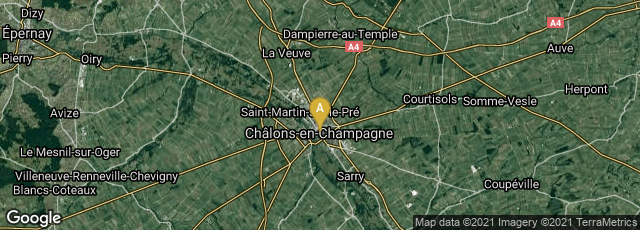
A: Châlons-en-Champagne, Grand Est, France
Barbat père et fils Issues "Évangiles des dimanches et fêtes" Chromolithographed on Double-Sided Coated Stock in Five Colors
1844

Jeremy Norman Collection of Images - Creative Commons
In 1844 chromolithographers Barbat père et fils of Châlons-sur-Marne (Châlons-en-Champagne), France issued a spectacular chromolithographed exhibition volume of 315 pages printed entirely on enamelled or coated paper entitled Évangiles des dimanches et fêtes, illustrés par Barbat père et fils. This volume may be considered one of the high points of chromolithography on enamelled card or "carton procelain" most often seen in the elegant trade cards issued by Belgian printers during the mid-19th century. Using the coated paper reduced the amount of moisture absorbed duriing the printed process, resulting in greater richness of the printed colors since they were absorbed less by the paper.
In his A History of Chromolithography: Printed Colour for All (2013) Michael Twyman provided an unusually detailed discussion of this work, most of which I quote in full from pp. 180-181:
"Judging by the book's imprint, whicch takes the form of a four-colour decorated page on the reverse of the half-title lettered 'Imprimerie lithographique de Barbat à Châlons-sur Marne', it was produced as a promotional exercise for the Barbat establishment. Some years earlier, what were described as Barbat's title-pages for gospels ['titres d'évangiles'] had attracted the attention of Desportes at the Paris Exposition des produits de l'industrie française of 1839, and it seems likely that these exhibits prepared the way for the book.
"Leaving aside its binding, copies of the book that have been seen all vary slightly. Two copies in the British Library, both printed throughout on coated paper, reveal the book in more or less the state in which it must have been issued. One of them still has its original thin enamelled-card covers, printed lithographically in gold from transferred type. The preliminary pages of both copies consist of a half-title dusted in two shades of gold, an imprint page (referred to above) printed in three colours and gold, a vignetted frontispiece showing Christ triumphant, and a decorated title-paged printed in warm grey and ultramarine plus two dusted shades of gold. Both have pages numbered to 315.
"Though Barbat worked in France, his book has clear Belgian associations. This is most obvious in some of its decorative boarders, many of which feature designs and technical methods of a kind found on Belgian trade cards of the period. Unusually for the time, the book's paper was coated on both sides, which allowed Barbat to introduce a range of inventive borders throughout, mainly with similar designs on facing pages (though one double-spread design crosses the back margin). These designs fall into two broad categories; some were printed in solid colours from several ink-drawn stones; others take the form of linear patterns and flourishes printed in one or two colours from a single stone (parts being inked selectively for the second colour) and then dusted with gold -and silver powders to produce iridescent effects of the kind associated with Belgian enamelled cards. As with such items, the most delicated linear designs were engraved on stone. Inevitably there is variation from copy to copy on these gold and silver dusted pages, since the dusting could not be controlled very precisely, but pages printed from several stones in the traditional manner appear to be very consistent in appearance.
"Though the borders of Évangiles des dimanches et fêtes are extremely varied in design, the book's text takes the same form from page to page and varies graphically only in its colour, which is usually that of the dominant hue of the surrounding border. All the text was transferred from modern-face types and printed lithographically almost miraculous consistency. This in itself was a major technical achievement and the quality of the transferring is worth comparing with similar work undertaken a few years earlier by the Didot establishment for Jean-François Champollion's Grammaire égyptienne (Paris: Didot frères, 1836 [-1841]. Not only was the Didot transferring extremely variable in quality, but the challenge proved too much even for this distinguished printing house, and just over halfway through production it gave up upon the transfer process and reverted to printing the text from type in the traditional letterpress manner....
"Évangiles des dimanches et fêtes was very much a family undertaking and, in addition to a prominent reference to the Barbat name on both the imprint page and title-page, 'Barbat', 'P. Barbat', and 'Barbat fils' are acknowledged as designers at the foot of many borders. This suggests that, like many other lithographic establishments of the day, the 'Imprimerie lithographique Barbat' was very much artist-driven...."
Timeline Themes
